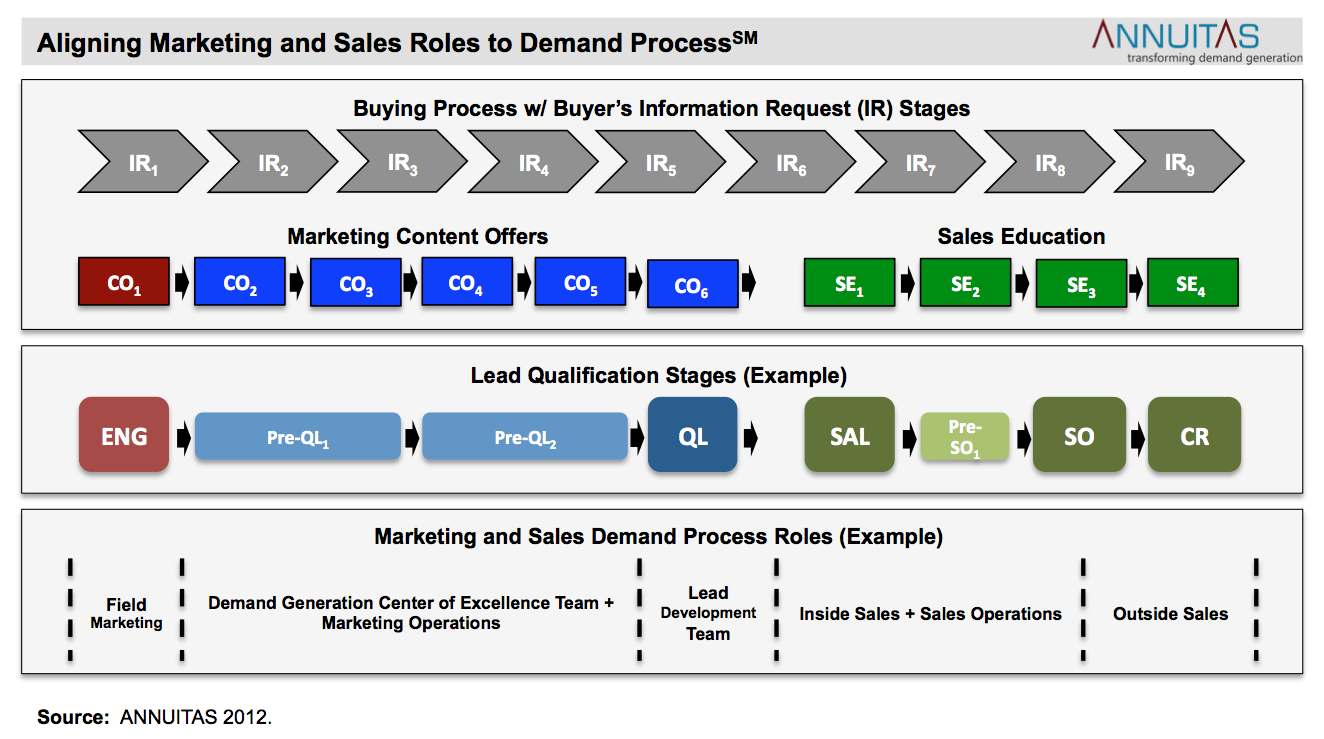By Adam B. Needles, Chief Strategy Officer, Annuitas
Conventional wisdom in B2B demand generation is maturing. There’s a growing awareness that strategic demand generation requires evolution of people, processes, content and technology – not merely marketing automation technology.
Conventional wisdom in B2B demand generation is maturing. There’s a growing awareness that strategic demand generation requires evolution of people, processes, content and technology – not merely marketing automation technology.
Yet this is still an area where B2B marketing and sales leaders struggle – particularly on the “people” part.
Many of us want to move our organizations toward a strategic, Web 2.0-savvy demand generation posture with an effective lead-to-revenue process. But our demand generation organization design – our “people,” and how we position them to enable our demand processes – does not reflect our ambitions. Rather than building holistic demand generation centers of excellence that transcend traditional views of marketing and sales roles, we remain saddled with legacy departmental distinctions, such as field marketing, product marketing, tele-prospecting and inside sales. These distinctions often do not successfully map to rational roles in enabling our demand processes.
What’s wrong with this picture?
- First, these distinctions reinforce a product-centric or sales-centric view of demand generation, rather than the buyer-centric view – they are more about us as product marketers and sellers than about our buyers and their needs. We remain focused on the tactics and the channels, rather than focusing on the overall objective. “Tech marketers are juggling too many tactical balls,” commented Forrester in its “2012 Tech Marketing Planning Guidance” report.
- Second, it’s often unclear how these roles rationalize against our lead-to-revenue processes. For example, is “field marketing” a top-of-funnel or bottom-of-funnel function? How does field marketing’s role compare to other marketing departments? Are we all just competing to generate “inquiries?” It’s no surprise 68% of B2B marketing and sales organizations characterize their organization’s lead management competency as “average” or “below average,” according to ITSMA’s 2011 report, “B2B Services and Solutions, Lead Management Benchmarks.”
So how should enterprise organizations approach building a best-in-class demand generation center of excellence?
- Lead with the demand process. The first step is to have a clear sense of the demand process an organization intends to drive. What is the desired dialogue with the buyer, how does that dialogue support his or her buying process, and how does this translate into a sequence of marketing content offers and sales education steps? What are the aligned lead qualification stages? Without this vision, it’s impossible to define marketing and sales roles to support this demand process. (The following is an example I show Annuitas clients to illustrate this point.)

- Marketing and sales must trade places. While many B2B marketing and sales teams remain rooted in legacy mindsets about each group’s “proper” contribution to the demand process, the truth is that the buyer sees it differently today. Buyer 2.0 conducts most of his or her education on a self-initiated basis via online and peer channels; engages sales later in the process; and expects sales team members to play much more of the role of “deal enabler.” Supporting this new content consumption pattern means marketing and sales essentially have to trade places a bit.
- Beware the “demand center” mirage. A successful demand process should orchestrate and govern all of your marketing and sales interactions with your buyer and deliver predictable revenues. The extended demand generation center of excellence serves as the steward of this process. Yet that does not mean the orientation of this center should necessarily be centralized.
In fact, many of the activities required to support a demand process happen across numerous digital channels and on the front lines with the buyer, all over the globe; they thus occur both at the center and the edge of the organization. Trying to force an overly-centralized organizational model – a so-called demand center – can in fact become a bottleneck and can hinder the demand process more than it helps.
In fact, more often than not, the right fit is often a hybridized approach in which some elements are centralized and others are distributed.
Adam B. Needles is a passionate B2B marketing change agent — helping companies build successful, modern, buyer-centric demand generation programs and transform their Demand Processes to drive profitable revenue growth and build sustainable brands. He is Chief Strategy Officer for ANNUITAS and the author of Balancing the Demand Equation: The Elements of a Successful, Modern B2B Demand Generation Model.
Adam has led marketing strategy and B2B demand generation programs for dozens of companies since the late 1990s. These include publicly-traded, Fortune 500 companies such as CA Technologies, Dell, E*TRADE FINANCIAL, Lenovo, Motorola, Pitney Bowes, Platinum Technology (acquired by CA Technologies), PNC Bank, PTC and Target. LinkedIn: http://www.linkedin.com/in/abneedles Twitter: @abneedles







